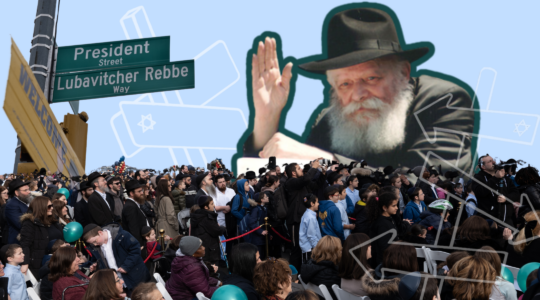While the leading role that Jews played in the formation of Hollywood is renowned, their outsize role in early Bollywood (India’s movie industry) is little known. The American Sephardi Foundation at the Center for Jewish History is celebrating this fairly unknown but exciting aspect of Jewish cultural history.
“Baghdadis and The Bene Israel in Bollywood and Beyond,” which is open through the end of March, is a small show comprised of informative panels, photographs, promotional postcards and posters, and other related ephemera. “Though there was a small amount of Jews living in India, there was a huge Jewish presence in Bollywood,” said curator Elisabeth Stevens during an exhibit walk-through with The Jewish Week.
Jewish actresses were able to expand their film careers taking on a variety of roles in front of the camera because they did not face the same rules as their Hindu and Muslim counterparts. In the early 20th century, it was considered improper for Hindu and Muslim women to appear in films, so in stepped actresses from India’s small Jewish community who weren’t “sequestered this way and tended to be more Western-oriented,” according to Stevens.
Sulochana, who was born Ruby Myers, for instance, was in a kissing scene in the film “Hamara Hindustan” in 1930, one that sent shockwaves through the conservative country. Briefly married to a German Jewish refugee, she was known as the “Queen of Romance,” and her stage name, Sulochana, means “the beautiful-eyed one.” In addition to starring in several movies, Sulochana had her own production company, which she called Rubi Pictures.
Esther Victoria Abraham, who was better known as Pramila, was a beauty queen (she won Miss India in 1947 though she was married and pregnant with her fifth child), an actress, and a film producer through her role as co-owner of Silver Films. She was a Baghdadi Jew from Calcutta who married a Muslim man, but she retained her Jewish identity, according to Stevens’ research.
The Jews of India are mainly comprised of two groups who immigrated at different times. The Baghdadis descend from a line of Iraqi merchants who came to India between the eighteenth and nineteenth centuries. The Bene Israel, the majority of India’s Jews, have lived in India much longer. Some say that the Bene Israel are descendants of one of the lost tribes. Many Indian Jews moved to Israel over the past 70 years, and so what were once two large, distinct groups have become two smaller groups that come together fairly often.
Stevens took a feminist lens to the material, highlighting the contributions and successes of women in Bollywood. She does include a section on some influential Jewish men who were actors, writers, and producers, though it is inconveniently and unintelligently located across the next room, past another unrelated exhibit.
In this panel we learn about Jewish men such as RJ Minney, an anglophile Baghdadi Jew who moved to England, changed his name from Reuben Joseph Minney to Rubeigh James Minney and wrote the novel “Clive of India,” which became a Hollywood movie. Joseph David wrote the first Bollywood “talkie,” “Alam Ara” (Light of the World) in 1931; it was so popular that police were needed to control the crowds hoping to see it.
The objects in the show are drawn from the personal collection of Dr. Kenneth X. Robbins, a psychiatrist, who is a collector and independent scholar on South Asian culture. As a child, Robbins collected Indian documents and court papers from places like Hyderabad, Jaipur, and Baroda. As an adult, in 1968 he saw Indian miniature paintings in a New York art dealer’s windows, and his interest was reignited; since then he has spent nearly 50 years collecting Indian objects and has published numerous articles and books about Indian culture and history.
Robbins continues to spend 10-15 hours per week with patients; he feels that “both [collecting and practicing psychiatry] involve recovering and looking at history.”
Robbins is working on a multi-volume history on the Jews of India and is planning an exhibit about them for the Indian government; it will take place in New Delhi in 2017.
Jason Guberman, executive director of the American Sephardi Foundation, noted that “There is tremendous interest in the Jews of Bollywood (and India more broadly), and we have received an outpouring of support from New York’s predominantly non-Jewish Indian community.”
The foundation will be hosting its annual Sephardic Jewish Film Festival this March and will be screening the Bollywood film “Beqassor,” starring Pramila. Upon hearing about the screening, Pramila’s granddaughter Roma reached out to the Foundation and wrote, “This is such a proud moment for her entire family.”
With such a tantalizing topic and so helpful and knowledgeable a collaborator as the ASF had with Dr. Robbins, it is a shame the exhibit is displayed in too small a space to go into enough depth or make clearer connections. Hopefully the success of this exhibit will inspire the ASF to tackle the topic again in the future on a larger scale.
“Baghdadis and The Bene Israel in Bollywood and Beyond” runs through March 31 at The Center for Jewish History – American Sephardi Federation, 15 W. 16th St., cjh.org.
The New York Jewish Week brings you the stories behind the headlines, keeping you connected to Jewish life in New York. Help sustain the reporting you trust by donating today.




